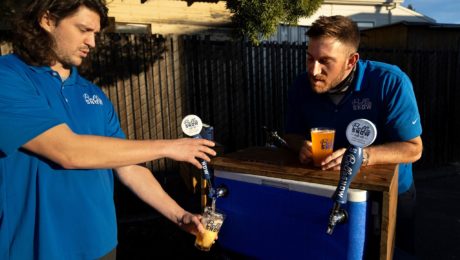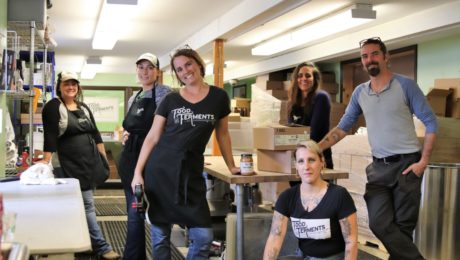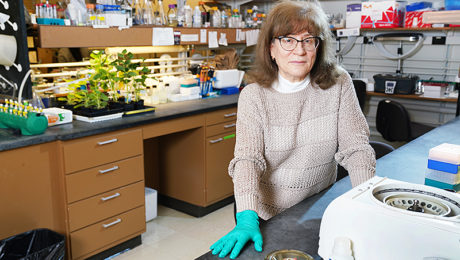From Chemist to Fermenter
Four years ago, Bob Florence, 62, made a radical turn in his decades-long career as an industrial chemist. With the help of his wife Debbi Michiko Florence and business partner James Wayman, he began making small batch soy sauce, miso and other condiments under the brand name Moromi (Japanese for “mash”) Artisanal Shoyu.
Florence always enjoyed cooking, but making soy sauce (shoyu) piqued his interest. “It’s technically really super challenging,” he says. The different types of soybeans, wheat, salt and koji that can be used to create different varieties were especially appealing. Florence trained in Japan with the president of Chiba Shoyu, Kyosuke Iida.
Florence’s partners bring their own skills and perspectives to Moromi. Wayman, a chef at Nana’s Bakery and Pizza and Grass and Bone Butcher Shop in Connecticut, focuses on using local ingredients, some of which he forages. Michiko Florence, a third-generation Japanese American, is a children’s book author who has made food and Japanese culture features of her books.
Read more (The Day)
- Published in Food & Flavor
“More Brew, Less Buzz”
The craft beer industry has been dominated by strong brews or alcohol-free varieties. The New York Times highlights how “craft brewers are increasingly aiming for the sweet spot in the middle.” Low-alcohol beers are growing in popularity, appealing to consumers who want moderation not abstinence.
“There’s just this completely unexplored space,” says Sean Boisson. He started Bella Snow Soft Ale in California, which focuses on ales with no more than 2.4 percent ABV (about half the strength of a traditional beer). Christophe Gagné, owner and brewmaster of Jack’s Abby Craft Lagers in Massachusetts, created a series of low-alcohol beers he calls the 2% Beer Initiative, which has become a bestseller. “I would much rather have two beers and not fall over,” he adds.
The trend is reflecting the preferences of older beer drinkers. Their bodies can’t handle the aftereffects of alcohol and they want to ease back into their IRL responsibilities without a hangover.
“We’re not surprised that lower-ABV. beers are coming of age because, well, millennials are coming of age,” said Lester Jones, the chief economist for the National Beer Wholesalers Association.
Brewers note low-alcohol beer is a challenge. A beer with less alcohol is not easier or even cheaper to produce. Low-ABV beers require less malt (the grains supplying the sugars that are fermented into alcohol) but, if hops are too plentiful, the flavor becomes bitter. And a quality low-alcohol beer also can’t be watery.
Read more (The New York Times)
- Published in Food & Flavor
Covid & the 4k’s: 4 Foods “Many People Don’t Know About”
Renowned professor, epidemiologist and author of The Diet Myth and Spoon Fed Tim Spector is encouraging people to eat the 4k’s: kefir, kombucha, kimchi and kraut. His studies found diet plays a role in preventing severe symptoms of Covid.
Spector is a leading expert on long Covid, the symptoms that can continue for extended periods after an initial infection. He leads the ZOE Covid Study, created by scientists and doctors at King’s College London (where he is based), Stanford, Harvard, Massachusetts General Hospital and health science company ZOE. Last year Spector helped research the attributes and predictors of long Covid, the results of which were published in the journal Nature Medicine.
A microbiome researcher, Spector advocates for people to eat a diverse diet to improve the trillions of microbes in the gut.
“We know from Covid now that your gut health is crucial for your immune system,” he told ITV. “If we can focus on our gut health…gut microbiome is really crucial.”
Diet must be high-quality to improve immunity, he stresses. In the ZOE Covid study, researchers have found eating “the right things and avoiding feeding (the gut) the bad things, that’s what made the difference to getting long Covid,” he said. Fermented foods have proven health benefits, but Spector says many people opt for cheaply-made yogurts and cheeses prevalent in the grocery store to get their daily dose of fermented foods. This dairy is full of sugar and artificial ingredients, which thwart the positive effects of fermentation.
“The other fermented foods that many people don’t know about are what I call the 4 k’s,” Spector says: kefir, kombucha, kimchi and kraut (sauerkraut). He encourages “small shots a day” of a fermented food or beverage. “That really is a powerful enhancer of your microbes. And all these things are going to be cheaper actually than taking multivitamins every day of your life.”
Spector is not a fan of supplements, like pill forms of vitamins and nutrients. Many are proven not to work, he explained. In his studies on the effects of supplements on long Covid, there were minimal benefits for women and none for men.
“People are much better off getting all their vitamins and nutrients by having a diverse diet,” Spector said.
- Published in Food & Flavor, Science
SCOBY as Water Filter?
Can you use bacteria to eliminate bacteria? Commercial water filters remove contaminants from water, but the pores eventually clog, causing water to filter more slowly. Now researchers are studying a living membrane to filter water: a kombucha SCOBY.
Researchers at Montana Technological University (MTU) and Arizona State University (ASU) found the films of cellulose that make up a SCOBY are 19-40% more effective than commercial filtration systems at preventing the formation of bacterial biofilms. The SCOBY filter also maintained a fast rate of filtration for a longer period of time. Though a biofilm did eventually form on top of the SCOBY, it contained fewer bacteria than in a commercial filter.
“The scientists couldn’t use the wild yeasts typically used in kombucha because the yeasts are difficult to modify genetically,” reads an article in Wired. “Instead, the researchers used lab-grown yeast, specifically a strain called Saccharomyces cerevisiae, or brewer’s yeast. They combined the brewer’s yeast with a bacteria called Komagataeibacter rhaeticus (which can create a lot of cellulose) to create their ‘mother’ SCOBY.”
Researchers engineered the cells in the yeast to produce glow-in-the-dark enzymes, which sense pollutants and break them down. SCOBY-based filters are not only inexpensive to make, they biodegrade when discarded.
Their research was published in the American Chemical Society journal ACS ES&T Water.
Read more (Wired)
Tastier Apple Spirits
Thanks to their high sugar content and strong flavor, apples have been a great base for spirits like cider, calvados and applejack for hundreds of years. But “many decisions about their processing are still subjectively determined.” When to stop distillation for the most flavorful liquor, for example, is open to question. But new research has identified the best conditions for making apple-based spirits with the most desirable qualities and taste.
Researchers with the American Chemical Society fermented apples into a mash, then distilled it in a German-style batch column. Heat concentrates the alcohol and “removes unpleasant fermentation byproducts, such as carboxylic acids that can impart unclean, rancid, cheesy and sweaty flavors.” The researcher’s mash was continuously monitored during heating, and the levels of the nine carboxylic acids measured.
Heating the mash too quickly yielded unwanted flavor compounds and a bland aroma. But raising the temperature of the cooling tower slightly produced a good fragrance intensity, and reduced carboxylic acid levels.
Read more (American Chemical Society)
- Published in Food & Flavor, Science
World’s Rarest Foods in Danger of Extinction
Journalist Dan Saladino explores the world’s endangered foods in his new book Eating to Extinction: The World’s Rarest Foods and Why We Need to Save Them. He argues that the world could lose culinary diversity. “The story of these foods, and the way in which they’re presented in the book,” says Saladino, from wild foods associated with hunters and gathers, to cereals, vegetables, meats and more, “is really the story of us and our own evolution.”
A review of Saladino’s book in Smithsonian Magazine shares 10 of the world’s rarest foods — five of them fermented. These rarities include:
- Skerpikjøt (Faroe Islands, Denmark): Dried and fermented mutton made from the shanks and legs of sheep. It ferments in wooden sheds called hjallur, which have vertical slats that allow space for the salty sea wind to blow in.
- Salers cheese (Auvergne, France): One of the world’s oldest raw milk cheeses made from the milk of Salers cows. The semi-hard cheese is made with varying fermentation lengths, which change the flavor.
- Qvevri wine (Georgia): Winemakers fill the egg-shaped terracotta pots called qvevri with grape juice, skins and stalks, then bury the pots underground. The steady temperatures and the pot’s shape allows even fermentation.
- Ancient Forest Pu-Erh Tea (Xishuangbanna, China): The fermented tea is made from wild tea leaves that grow in China’s southwestern Yunnan province. The leaves are sun-dried, cooked, kneaded, then formed into solid cakes and fermented for months (or years).
- Criollo Cacao (Cumanacoa, Venezuela): The world’s rarest type of cacao, it represents less than 5% of the cocoa production on the planet. The bean lacks bitterness, but is difficult to grow.
Read more (Smithsonian Magazine)
- Published in Food & Flavor
Beet Kvass: Next Fermented Favorite?
A sign beet kvass is experiencing popularity in America’s artisanal food culture: a beet kvass by New York-based Food & Ferments won a Good Food Award from the Good Food Foundation.
“I kind of describe it as a beet pickle juice,” said Carly Dougherty, co-owner (with her husband Dave) of Food & Ferments. “It’s savory. It’s got ginger and garlic in it as well. It’s not just a beet flavor. It’s really got this, like savory, beet pickle juice kind of vibe to it.”
Kvass originated in Eastern Europe. The Doughertys source their beets locally, which they say makes the beets juicier and better tasting. It ties into their mission to make products “tied to the local landscape that supports farmers.”
This is the second Good Food Award for Food & Ferments. Their first award in 2018 was for their Hearts on Fire Sauerkraut.
Read more (The Ithaca Voice)
- Published in Food & Flavor
Yogurt Alters Gut Microbiome
It’s widely appreciated that consuming high-quality yogurt can aid a healthy diet. Now new research shows eating yogurt changes the composition of the human gut microbiome.
In a new human study published in BMC Microbiology, researchers studied the microbiome of European twins. Results found those regularly eating yogurt had less visceral fat mass, reduced insulin levels and an increase of bacterial species in the gut. Strains S. thermophilus, B. animalis subsp. lactis., S. thermophilus and B. animalis subsp. lactis were all present in yogurt eaters.
The study also found the yogurt bacteria are “transient members of the gut microbiome and do not durably engraft within the gut lumen.”
Read more (BMC Microbiology)
Fermentation Key to Mass Producing Anti-Cancer Compounds
Thyme and oregano possess an anti-cancer compound that suppresses tumor development, but adding more to your tomato sauce isn’t enough to gain significant benefit. The key to unlocking the power of these plants is in amplifying the amount of the compound created or synthesizing the compound for drug development.
And exciting for the field of fermentation: extracting those beneficial compounds from the plant is done through fermentation.
“The fermentation process is so important to food and beverage, pharmaceutical and biofuels production that Purdue now offers a fermentation science major,” reads a press release from Purdue University.
Researchers at Purdue took the first step in using the compound in pharmaceuticals by mapping its biosynthetic pathway, a sort of molecular recipe of the ingredients and steps needed.
“These plants contain important compounds, but the amount is very low and extraction won’t be enough,” said Natalia Dudareva, distinguished professor of biochemistry in Purdue’s College of Agriculture and director of Purdue’s Center for Plant Biology, who co-led the project. “By understanding how these compounds are formed, we open a path to engineering plants with higher levels of them or to synthesizing the compounds in microorganisms for medical use. “It is an amazing time for plant science right now. We have tools that are faster, cheaper and provide much more insight. It is like looking inside the cell; it is almost unbelievable.”
Thymol, carvacrol and thymohydroquinone are flavor compounds in thyme, oregano and other plants in the Lamiaceae family. They have antibacterial, anti-inflammatory, antioxidant and other properties beneficial to human health. Thymohydroquinone has been shown to have anti-cancer properties and is particularly of interest, said Dudareva..
In collaboration with scientists from Martin Luther University Halle-Wittenberg in Germany and Michigan State University, the Purdue team uncovered the entire biosynthetic pathway to thymohydroquinone, including the formation of its precursors thymol and carvacrol, and the short-lived intermediate compounds along the way.
The findings alter previous views of the formation of this class of compounds, called phenolic or aromatic monoterpenes, for which only a few biosynthetic pathways have been discovered in other plants, she said. The study results were published in the Proceedings of the National Academy of Sciences.
“These findings provide new targets for engineering high-value compounds in plants and other organisms,” said Pan Liao, co-first author of the paper and a postdoctoral researcher in Dudareva’s lab. “Not only do many plants contain medicinal properties, but the compounds within them are used as food additives and for perfumes, cosmetics and other products.”
Now that this pathway is known, plant scientists could develop cultivars that produce more of the beneficial compounds, or it could be incorporated — using fermentation — into microorganisms like yeast for production.
A $5 million grant from the National Science Foundation supported the research. Using RNA sequencing and correlation analysis, the team screened more than 80,000 genes from plant tissue samples and identified the genes needed for thymohydroquinone production. Based on what was known about the compound structure and through metabolite profiling and biochemical testing, the team identified the biosynthetic pathway.
“The intermediate formed in the pathway was not what had been predicted,” Liao said. “We found that the aromatic backbone of both thymol and carvacrol is formed from γ-terpinene by a P450 monooxygenase in combination with a dehydrogenase via two unstable intermediates, but not p-cymene, as was proposed.”
More pathways are now being discovered, thanks to the availability of RNA sequencing to perform high-throughput gene expression analysis, according to Dudareva.
“We, as scientists, are always comparing pathways in different systems and plants,” Dudareva said. “We are always in pursuit of new possibilities. The more we learn, the more we are able to recognize the similarities and differences that could be key to the next breakthrough.”
- Published in Science
“So Stinky, Delicious, Irresistible”
“It’s fermented. It’s stinky. It’s delicious. And during the pandemic, it’s become a national sensation.”
Luosifen — snail noodles — is the subject of NPR’s latest All Things Considered program. The Chinese dish is made with rice noodles soaked in a broth of peeled river snails. It’s then topped with tofu, lemon vinegar and bamboo shoots (which have been covered in salt and fermented for a few weeks).
“Much of the preparation relies on fermentation, common in cuisine from southern Guangxi province where the noodles first began,” the NPR piece continues. “Their malodorous reputation also makes snail noodles quite possibly one of the worst meals to make at home: The smell of the pickled toppings and the stewed snails can linger for hours.”
Social media stars began sharing about the “disgustingly good snack” in 2020 during the Covid-19 pandemic. As a result,over 1.1 billion packets of snail noodle home kits were sold last year. And the city in China where snail noodles originated 25,000 years ago — Liuzhou — is experiencing an economic boom, as the nationwide popularity brings new business to snail noodle food stands, factories and chain restaurants.
Read more (NPR)
- Published in Food & Flavor










